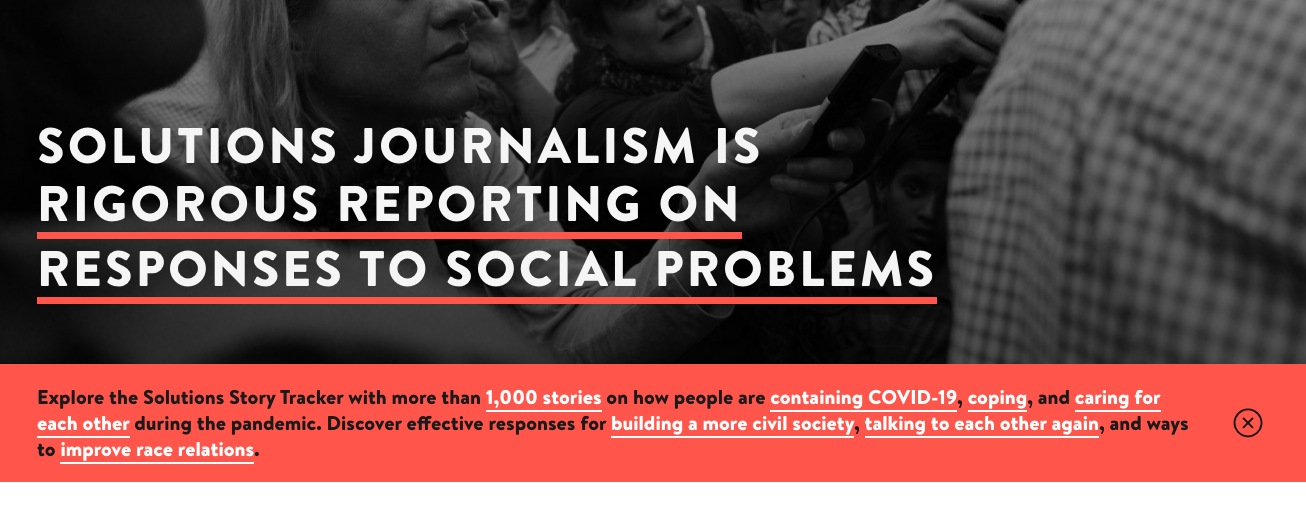Trends
Solutions Journalism: How to Get Work Telling Public Interest Stories
By Rudri Patel April 21st, 2021Every day, media outlets release distressing reports on gun violence, natural disasters, or public health crises. But not many of these stories provide a potential solution to the problems they cover.
This is precisely what “solutions journalism,” an emerging discipline, hopes to change.
“[Solutions journalism involves] rigorous reporting on what’s working or investigative reporting on what’s going right” for various social issues, said Julia Hotz, communities manager for the Solutions Journalism Network (SJN).
If you’re a freelancer drawn to this type of work, here’s how you can get started.
What does solutions journalism look like?
Solutions journalism can take different formats including documentary films, longform articles, or radio stories. Most stories focus on a widespread social problem, such as containing COVID-19, educating students during the pandemic, and improving race relations in the U.S. and around the globe.

Although these stories discuss a variety of social issues, there are four core pillars to solutions journalism:
- First, the story must focus on a response to a problem and how it works.
- It must cover how and why past response tactics have fallen short.
- Proposed solutions must be based on evidence.
- And finally, the story should identify how other communities can adopt similar responses.
For example, take the CAHOOTS Program in Eugene, Oregon, which assembles teams of unarmed mental health crisis workers who respond to 911 calls instead of police officers. This piece about CAHOOTS in the Wall Street Journal meets the criteria for solutions journalism by showcasing a response (an experimental program) to an issue (police brutality), how it is impacting a specific community (early successes backed up by data), and actionable ways others might benefit from the program’s early learnings (how other towns might implement similar programs).
Joining the Solutions Journalism Network
Any publication can produce solutions journalism, but there’s a nonprofit called the Solution Journalism Network (SJN) dedicated to training editors, reporters, and the public on best practices for this type of work.
Writers interested in joining can fill out a short form to become part of the Solutions Journalism Talent Network, where editors directly commission stories. The network also offers a newsletter and Facebook group. SJN is funded by donations, so it doesn’t cost anything to join.

On the platform, freelancers can educate themselves through webinars and other resources. In the Learning Lab, there’s a basic toolkit on solutions journalism, as well as guides on topics like education, violence, economic mobility, and health. The network also provides a free Solutions Story Tracker, where you can find pieces on the pandemic, prison systems, wildfires, and other social issues. You can search this 12,000-story database by topic, date, media type, news outlet, journalist, and more.
If you’ve already published a story that falls under the solutions journalism umbrella, you can submit your piece to the database. Alternatively, if you have a new pitch for a story and want to know if editors are interested, visit SJN’s The Hub and select, “Pitch your story.” There are currently more than 40 editors soliciting pitches. (You must be a member of SJN to submit ideas.) Rates and emails are in each listing.
How to search for your next story
Whether you’re a new writer or longtime reporter, mastering this evolving format requires a specific mindset. Here are three tips for aspiring solutions journalists.
Shift your lens. Journalists tend to be trained by the adage, “If it bleeds, it leads.” As such, they’re often conditioned to focus on bad news and crisis moments. Solutions journalism acknowledges these crises exist, but approaches the topic from a different perspective. When constructing pitches, remember to prioritize how people are addressing a problem rather than the problem itself.
Focus on a small slice of a problem. Huge social issues like climate change are too complex to be solved by an individual or small group. So it usually makes sense for solutions journalists to tell a smaller story with clear specifics.
“If a writer covers climate change, he or she can analyze the amount of cars on the road contributing to greenhouse gases and air pollution,” Hotz suggested. The writer can then look at cities like London and New York experimenting with congestion pricing, which charges a tax on cars that travel in super-congested areas. The tax is then reinvested in the public transport system. That’s a more manageable way to frame a climate change story without going too broad.
Live a life of curiosity. Chris Malloy, a Phoenix-based writer who has written a few solutions journalism stories, doesn’t necessarily hunt for solutions-based work, but follows his curiosity and asks questions. “With the pandemic, I was tired of reporting on stories that were depressing and sad,” he said. “It feels satisfying to identify problems and obstacles and also probe sources for solutions.”
Image by ilyast